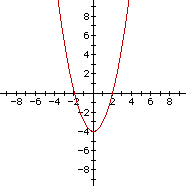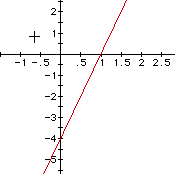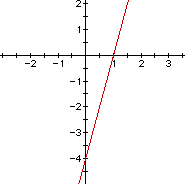

Because the understanding of quadratic functions in mathematics is an
integral concept and a stepping stone for higher-level mathematics, Algebra
students must not be presented with solving quadratic equations in a vacuum.
Not only must they be exposed to solving quadratic equations algebraically
by using the quadratic formula, but seeing how the discriminant is graphically
related to the roots of a quadratic equation should provide a better understanding
of how and what kind of roots are obtained when solving quadratic equations.
The focus of this paper is to further clarify the use of the discriminant
in solving quadratic equations by graphing the discriminant (d) such that
![]() for different values of
a, b, and c as the other two coefficients are held constant. From these
graphs, discussions of the patterns for the roots of
for different values of
a, b, and c as the other two coefficients are held constant. From these
graphs, discussions of the patterns for the roots of ![]() can be followed.
can be followed.
After graphing several quadratic functions, students should begin to understand the aspects of horizontal and vertical shifts, symmetry, and reflections across the x-axis. Thus, graphing a parabola allows the students to approximate the roots of a quadratic. However, although graphing even with the most sophisticated means of technology may give adequate estimates of roots, the graphs may not be exact and not much attention is given to the actual discriminant of the quadratic equation in terms of different types of roots, i.e., real, imaginary, and rational. Therefore, not only must students be familiar with the discriminant, but they must also realize how the discriminant acts as specific coefficients are held constant. When specific coefficients are held constant, not just specific graphs are depicted, rather, a whole family of equations can be identified for which roots are either complex or rational.
In the quadratic formula,![]() , is called the
discriminant because it allows us to discriminate whether a parabola has
zero, one, or two real roots. Thus, if the discriminant is positive, than
it has a real value and the quadratic formula gives us two distinct roots.
If the discriminant is zero, the quadratic formula simplifies to the expression
for the horizontal position of the vertex and the function touches the x-axis
at only one point, which is the vertex. Thus, the function touches the x-axis
at only one point which is the vertex and the vertex is the only root. Lastly,
if the discriminant is negative, the discriminant has no real value because
it is impossible to take real square roots of negative numbers. Since the
function has no real root, it does not cross the x-axis.
, is called the
discriminant because it allows us to discriminate whether a parabola has
zero, one, or two real roots. Thus, if the discriminant is positive, than
it has a real value and the quadratic formula gives us two distinct roots.
If the discriminant is zero, the quadratic formula simplifies to the expression
for the horizontal position of the vertex and the function touches the x-axis
at only one point, which is the vertex. Thus, the function touches the x-axis
at only one point which is the vertex and the vertex is the only root. Lastly,
if the discriminant is negative, the discriminant has no real value because
it is impossible to take real square roots of negative numbers. Since the
function has no real root, it does not cross the x-axis.
Consider the discriminate of the above quadratic,
After having graphed quite a few quadratics most students would have a mental picture of this graph. The interesting thing here is that d, the discriminant, is a function of b, the coefficient of the linear term. If we graph the quadratic equation that the discriminate yields we have:

So, just exactly what are we looking at here? Remember since b is the independent variable, it is represented by the x-axis and since the discriminant is the dependent variable it is represented by the y-axis. Hence the discriminant, d is: negative if -2 < b < 2 ; is zero if b = 2 or -2; and is positive if -2 < b > 2. Thus, the only solvable equations, in real numbers, of the form
What would the graph of the discriminant have to look like for the equation
![]() to be solvable
for all real values of b?
to be solvable
for all real values of b?
Can the vertex have a non-zero b coordinate?
The discriminant of this function has the form d = 4 - 4c and a graph

Here the dependent variable (on the y-axis) is d and the independent variable (on the x-axis) is c. If c< 0 the value of the discriminant is negative, hence the quadratic is not solvable in real numbers. If c is greater than or equal to zero the discriminant is nonnegative, hence the quadratic is solvable.
What would the graph of the discriminant have to look like for the equation
![]() to be solvable for all
real values of c?
to be solvable for all
real values of c?
When we compute the discriminant of the function ![]() , we
get a linear equation d = 4 - 4a. This equation has the same graph as before
only now the independent variable (x-axis) is a.
, we
get a linear equation d = 4 - 4a. This equation has the same graph as before
only now the independent variable (x-axis) is a.

So we see that all quadratic equations of the form ![]() , where a >
1 are solvable in real numbers.
, where a >
1 are solvable in real numbers.
What would the graph of the discriminant have to look like for the equation
![]() to be solvable for all real
values of a?
to be solvable for all real
values of a?
Because it is obvious from the examples above that various quadratic equations are not solvable in real numbers, teachers could use the discussion and examples above as a spring board for discovering and defining imaginary and complex numbers. When graphing a parabolic equation, if the parabola does not touch the x-axis, the equation does not have solutions in the real number system. Conversely, if the discriminant is graphed, as in the examples above, equations do not have real roots when the graph lies below the x-axis. Thus, not only can teachers show students explicit examples by graphing specific parabolas, but they can also show students general equations as discussed in this paper.
The relationship between the discriminant of a quadratic equation and the solutions (x-intercepts or zeros of the equation), the vertex of the equation, and other various shifts and movements of the equation can be discovered by graphically representing different aspects of the discriminant. Using this type of discovery will surely enhance a deeper understanding and conceptual base for students.